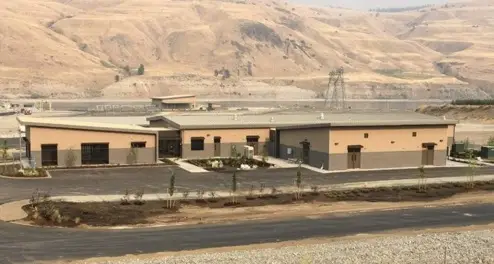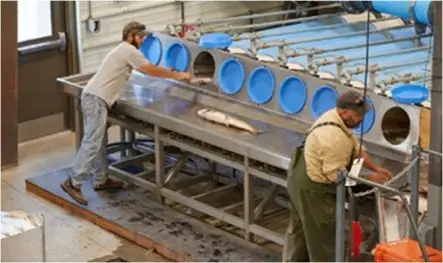Facility Design Engineering
 FSPs fisheries engineers have engaged in hatchery planning, feasibility assessments, facility/ useful life assessments, rehabilitation recommendations, alterations of infrastructure, detailed design, bio-programming, and construction support throughout the Pacific Northwest and Canada. Our team has worked hand-in-hand with First Nations, Tribes, State Agencies, Utility Districts and Federal Agencies in the United States and Canada for more than two and half decades.
FSPs fisheries engineers have engaged in hatchery planning, feasibility assessments, facility/ useful life assessments, rehabilitation recommendations, alterations of infrastructure, detailed design, bio-programming, and construction support throughout the Pacific Northwest and Canada. Our team has worked hand-in-hand with First Nations, Tribes, State Agencies, Utility Districts and Federal Agencies in the United States and Canada for more than two and half decades.
Our collective experience with so many different facilities bring a vast array of knowledge and approaches to addressing aging infrastructure to extend the life of or replace the asset, incorporating new processes and rearing systems.
Implementation of rehabilitation or replacement of assets often requires that production not be uninterrupted during construction. At FSP we have extensive experience developing unique sequencing plans to keep facilities in operation during periods of construction so that a year’s class will not be missed, or obligations interrupted.
Hatchery Design
Hatchery facility planning, design, and construction is a complex process that merges the biological science of fish culture with the technological sciences of engineering. At FSP we provide detailed knowledge and experience related to salmonid life stage requirements (incubation, rearing, holding, and spawning) and fish culture facility components, techniques, and strategies. Our team’s experience specific to fish hatcheries includes site layout, constructability, site access roads, egg incubation systems, rearing and spawning tanks, and all associated water supply piping and drains. Our team is familiar with civil and constructability issues such as maintaining operation of fish facilities while providing construction access. Many of our projects require that the hatchery remain functional during construction.
Sample of the Hatcheries Our Team Has Performed Consulting Services for:
- IDFG: Springfield Fish Hatchery
- SSSC: Sitka Sound Science Center
- DFO: Quinsam Hatchery
- DFO: Capilano Hatchery
- DFO: Cowichian Hatchery
- DFO: French Bar Facility
- CDFW: San Joaquin Hatchery
- WDFW: Beaver Creek Hatchery
- WDFW: Samish Fish Hatchery
- WDFW Deschutes River Hatchery

Water Quality Assessment & Treatment
Providing optimal water quality throughout a facility is essential for all fish life stages. FSP’s Engineers have designed hundreds of water treatment systems. Ground water treatment uses gas management systems to bring dissolved gas level to near saturation levels or to supersaturate the water with dissolved oxygen. Surface water treatment systems target various pathogens that cause harm to fish. Technologies used to eradicate or knock down pathogen load are mechanical filtration, UV disinfection, Ozone disinfection, or a combination thereof. Sediment management of incoming surface water is critical as sediment can build up in rearing systems. Pre-settling ponds, cyclone separators, or other types of mechanical filtration can be applied to remove fine sediment from surface water.
Recirculating Aquaculture Systems (RAS)
Limited water resources, water pollution control, water use permit requirements, and energy management have led FSP to incorporate systems that recirculate and reuse water to meet the environmental constraints in our changing climate. Full or partial recirculating aquaculture systems (RAS & PRAS) can help minimize water use, allow fish production in regions where water is scarce, and allow programs to be expanded. FSP fisheries engineers understand the technology and engineering required to create a recirculation system that allows the water leaving a fish culture tank to be reconditioned and then recirculated and/or reused in the aquaculture system.
FSP fisheries engineers have designed many water supply systems that use well water, surface water, spring water, or a combination thereof. These water supply systems range from single pass to multi-pass reuse or recirculation systems up to 95% recirculation.
PRAS Systems Designed by FSPs Engineers:
- Nisqually Tribe: Kalama Creek Hatchery
- Lummi Nation: Lummi Bay Hatchery
- WDFW: Kendal Creek Hatchery
- Hoh Tribe: Chalaat Creek Hatchery
- CDFW: Moccasin Hatchery
- DFO: Kitimat River Hatchery

Adult Holding Facilities & Fish Handling System
FSP fisheries engineers have extensive experience with providing final design documents for facilities that include holding and trapping and hauling for moving fish from the trap to a release destination. As part of the design, many areas are reviewed to generate the criteria associated with fish health, sorting, holding time, volume of fish, quality of water, equipment selection and design, predation prevention, turning movements of transfer trucks, and site layout.
Typical facilities include mechanical crowders, false weirs, pneumatically controlled diverter chutes to sort fish into multiple holding tanks, lift buckets, water supply systems, gates, screens, and public viewing. Our projects consider fish health as the number one priority in moving fish from the trap to a release destination. This also includes truck transfer conditions.
Fish Sorting, Hold, and Handling Facilities Designed by FSPs Engineers:
- DCPUD: Wells Hatchery
- WDFW: Forks Creek Hatchery
- WDFW: Tumwater Fall Hatchery
- DCCD: Rock Creek Hatchery

